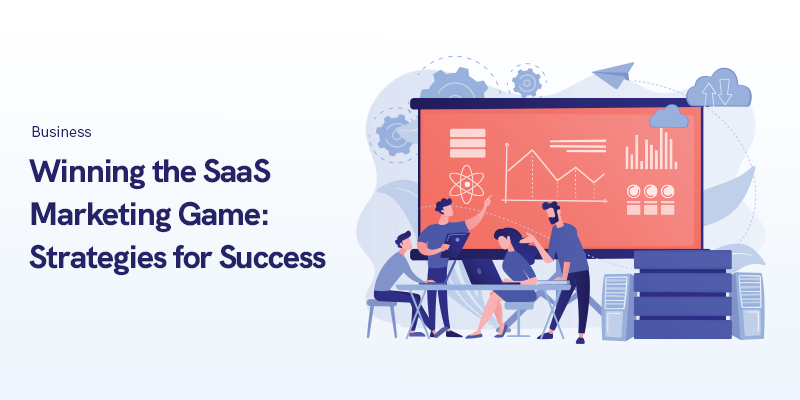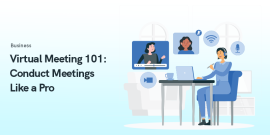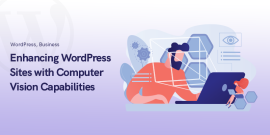
Winning the SaaS Marketing Game in 2024: Strategies for Success
Software as a Service (SAAS) is a perfect model for businesses over the internet.
It helps the users easily fetch anything they need directly from the server; they don't need to get their own copies.
SaaS usually provides highly flexible solutions.
The ease these kinds of cloud- base systems provide urges clients to move to this service.
As per the growth rate of the businesses, SaaS products are considered the best source.
Developing an effective marketing plan for your SaaS business and executing it requires thorough understanding and research.
It involves telling stories, experimentation, and gaining newer perspectives.
It’s the science of understanding the interests of your prospects, figuring out what they want from a product, and how you can deliver it.
Here you'll learn all the startup steps to start the SaaS business and then we will dive into looking at the strategies to reach success.
The guide will discuss the target marketplace and a strong market plan.
A Complete Guide to Build a SaaS Startup
Let's discuss the 7 main points of the SaaS startup.
Step 1. Define the Overall Values of Your Product
If you want to understand how to build a SaaS business, one of the first things you should do is figure out what value you provide that clients will need.
While responding, ensure that there is a perfect fit between where you see your item and how it makes it easier for people.
As a result, when branding to potential customers and business partners, you can accurately interact with its value from the start.
So, don't be afraid to speak with prospective clients and other distributors in your industry to learn about their challenges.
Step 2. Research the Target Market
Here, the focus is on the target market. When you get the desired audience, you will check on their basic needs and fundamental factors like age, lifestyle, etc.
It will give you a clear understanding of what you need to provide them. You will get their likes and dislikes to make your preferences clear.
Learning your target audience's needs and interests will help you build solid SaaS marketing strategies.
Step 3. Choose the Best-Fit Pricing Model
You can set your cost when you've characterized your value and discovered what other businesses are doing to provide the same worth.
It's essential to make this decision now so that your subsequent actions are consistent with the value you anticipate customers will pay for your quick fix.
Your pricing scheme must be consistent with your target market and mission statement.
Even if a relatively small portion of high-value users is prepared to spend more on top-of-the-product lines, the result will be fewer customers.
Step 4. Build the Brand for Your Startup
Once you've accomplished the basic steps, you can begin visualizing your prospective SaaS product.
At this point, it's worthwhile to design a prototype that illustrates your view of how customers will interact with your product.
The designing step is extremely useful for determining potential flaws in your project and seeing how your product would look.
Constructing a prototype, in particular, allows you to modify your vision and identify any specialized or market issues before the advancement stage begins.
Step 5. Get an Initial Financing Idea
Understandably, before starting a SaaS company, you'll want to know exactly how much your endeavor will cost. To get an idea of what's involved in launching and running a successful SaaS venture, rely on our expertise in the SaaS development domain to get the idea of the development process and prices.
Step 6. Create a Strong Development Team
Locate developers with expert-level knowledge of building SaaS applications and form a team across you.
One method is to call them on LinkedIn, tell them your thoughts, and request if they'd like to learn more.
Step 7. Launch an MVP
“Develop MVP” is the easiest answer to start a SaaS business.
A minimal viable product (MVP) is a SaaS app version that includes a set of basic features for initial reviewers to evaluate and recommend whether or not they want them in a final version.
In general, the MVP is an excellent method to evaluate the waters and see what benefits your proposed business will offer.
Building a Winning Strategy to Market Your SaaS Company
Now let’s take a look at the steps to developing a winning marketing strategy for your SaaS business.
Identify your goals
To craft an effective marketing strategy, having a well-defined set of realistic goals is crucial.
It’s also crucial to have a mission statement that encapsulates your business’ purpose and how you plan to achieve it.
From helping you build a mission statement to developing and implementing the strategy, a reputable agency will help you throughout the process.
With this in mind, your marketing goal could be to attract a certain number of new prospects and increase bookings by a specific percentage.
Thorough market research
Data-driven decision-making is at the heart of a winning marketing strategy.
To ensure your marketing strategy performs as desired, make sure to conduct proper market research and gain insights into your industry, competitors, and target audience.
Identify your business’ strengths and weaknesses, assess market trends, and uncover opportunities to capitalize on.
Know your prospects
Your prospects are the lifeblood of your business.
Understanding their interests and building your products and marketing campaigns is essential.
Figuring out their needs, wants, and preferences will help you tailor marketing messages that connect with them.
This targeted marketing approach will help increase the effectiveness of your campaigns and build stronger connections with potential customers.
Choose the right channels
To reach more people without spending heftily, it’s essential to choose the right marketing channels.
So, start with analyzing your audience’s preferences and behavior.
Most businesses looking for SaaS products can be active on LinkedIn.
However, apart from that, targeted Instagram and YouTube campaigns can also reap good results.
Personalize your campaigns
Personalized marketing is gaining more importance by the day.
Customers expect personalized experiences targeted toward their individual personalities and needs.
One simple method of executing this could be using your prospect's name while sending out a message.
For example, instead of writing Hi Sir, businesses can write Hi (Name of the recipient).
Define objectives
In addition to your overall business goals, establish specific and measurable objectives for your marketing strategy.
These objectives serve as milestones that contribute to your goals.
Defining clear objectives allows you to track progress, measure success, and make data-driven adjustments along the way.
Create compelling content
High-quality content is critical for an effective marketing strategy.
Create interesting and valuable content that caters to your audience’s interests and needs.
By providing valuable content, SaaS businesses can showcase their expertise, build credibility, and position themselves as the go-to resource in their industry.
Monitor, measure, and optimize
To gauge marketing efforts' effectiveness, monitoring and measuring results is essential.
Businesses should track key performance indicators (KPIs) that align with their marketing objectives.
This data-driven approach provides valuable insights into what’s working and what needs improvement.
Consider newly launched information working towards its SEO goals.
They’ll need to track metrics such as engagement, website clicks, page views, and traffic source(s).
Stay agile and adaptable
The marketing world is ever-evolving, and staying agile is crucial to maintaining a competitive edge. It’s crucial to stay in sync with emerging technologies and changes in consumer behavior.
By aligning your marketing strategy with emerging trends and customer preferences, your business can attract a new segment of customers and stand out from your competitors.
Collaborations are the way to go
Collaborations are taking the main stage in the present marketing scenarios.
By collaborating effectively with relevant creators, businesses can achieve their marketing goals and discover new possibilities.
For this reason, it’s advisable for businesses to keep innovating, hold brainstorming sessions, welcome ideas from team members, and embrace a culture of experimentation and testing.
Regular team gatherings and collaborations can fuel innovation, helping your brand do better with every marketing campaign.
Conclusion
You now understand how to launch a SaaS company.
However, once your company is up and running, you must assess its success.
As you'll see, launching a SaaS company necessitates a detailed plan and recognition.
An integral part of this recognition and assessing the company's success involves leveraging SaaS social media marketing to enhance visibility and engage with your target audience effectively.
The world of marketing moves at a fast pace.
To succeed with your SaaS business’ marketing strategy, it’s crucial to be in sync with the latest trends and best practices.
In this blog, we shared a few critical steps that can help SaaS businesses present themselves better on and off the web.
Recommended Posts

Top 6 Free Windows Screen Recorders for Your Personal Blog
February 8, 2024

Virtual Meeting 101: Conduct Meetings Like a Pro
January 1, 2024

Enhancing WordPress Sites with Computer Vision Capabilities
December 27, 2023